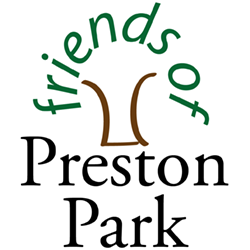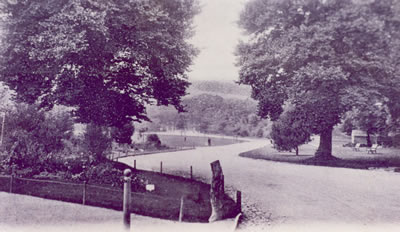by Selma Montford
The land, which eventually became Preston Park, was part of the Manor of Preston. It belonged to the Bishops of Selsey, and later Chichester, from before the Norman Conquest until 1561 when it became Crown property.
The Manor ceased to be Crown property in 1628 when it passed to the Shirley family who owned the Manor until 1712. Their steward described “the Mansion House of Preston” with “a gatehouse, stables, coach house and other outhouses, barns, gardens, orchards, bowling green with a plantation of young elms”. William Stanford bought Preston Manor and nearly 1,000 acres of land from his landlord Charles Western in 1794 for £17,000.
The land, open meadows divided by fenced hedgerows with trees, was probably used for sheep farming in the 17th and 18th centuries. In a dry year is sometimes possible to see a green ring in the grass close to the Tile House, which may have been a dewpond. The Park was demesne land, i.e. it was farmed by the lord of the manor and not let to tenant farmers.
The ‘Ha-Ha’, which forms the southern boundary of the old croquet lawn of the Manor, was a normal garden wall in the 16th century when the land sloped naturally from northeast to southwest.
The population of Brighton had grown considerably by the late 19th century and it was necessary to provide leisure facilities for rich and poor. In 1871 William Davies, a Brighton bookmaker, made a bequest of £70,000 to the corporation and according to the will this money had to be spent on buying 67 acres of meadow for £50,000 from Mr and Mrs Bennett-Stanford.
Preston Park, originally known as Brighton Park, was opened to the public just a week after its purchase. The Brighton Herald reported on the opening on 13 September 1883 “now that the park is actually in the possession of the inhabitants [of Brighton] we think the town may fairly be congratulated on the excellent judgement which has been shown in adding to it what will undoubtedly prove one of its most pleasant and permanent additions, and that, too, at an almost nominal charge upon the rates”.
The Head Gardener, Mr Shrives and Mr Lockwood, the Borough Surveyor carried out improvements. Iron railings were erected along the Preston Road side with an avenue of trees: elms, chestnuts, ash and poplars. Flowers and shrubs were planted, seats installed, and a driveway established.
The first building to be erected in the park in 1883 was the Tile House, originally the ladies cloakroom. In 1886 the drinking fountain was moved next to it from outside the south gate as local children were creating a nuisance by playing with it.
The Mayor, Alderman A H Cox on 8 November 1884, officially opened the Park. The sun shone, bunting and flags hung for the trees and 1,200 people came to see the procession led by the Mayor and his wife.
On 3 January 1884 the Town Council approved the byelaws which included the following:
- No cattle, carriages, barrows, bicycles, tricycles were allowed in the Park, though perambulators for children and wheeled chairs for invalids were allowed.
- Other bye-laws prohibited being in charge of a dog without a lead or string, disturbing or injuring birds in their nests, drying or bleaching linen, beating carpets, selling alcohol, preaching, setting up a stall or playing games except in the designated spaces.
A pair of handsome gates was erected at the southern main entrance, with an equestrian drive – Rotten Row – on the east side. The middle gates opened from the Preston Road opposite Lovers Walk onto the driveway, with another gate at the northern end, and a small gate at the north eastern end leading to Preston Park Avenue. The Chalet café was opened in 1887 with the park police occupying the upper rooms from where they had commanding views over most of the Park.
‘In and Around Brighton and Hove’, a guide book published in 1908, lists features in Preston Park: a drive, cinder racing and cycling tracks, cricket ground, polo, archery, athletics meetings, Lovers Walk, the Chalet tea rooms and the clock tower.
The clock tower, officially handed over to Brighton Corporation on 17 June 1892, was designed by Francis May, the Borough Engineer, in the Flemish Renaissance style. It is 65’ tall and each clock face is 5’ in diameter.
A cricket ground was laid out in 1887 on the international Gun Polo Club ground at the north end of the Park, with open air seating for thousands of people. A wooden grandstand seating for 500 people was erected in 1930. The arena was also used for athletics meetings.

In the 1930s Captain MacLaren, the Parks Superintendent, remodelled the gardens by removing the iron railings and the southern entrance lodge. Shrubs were removed to make space for new tennis courts, bowling greens and pavilions. A flower-lined path between the tennis courts led to the formal rose garden, a fountain, a pond and the Rotunda café. In the 1930s balustrades and dolphin lamp standards were added to the new entrances.
Captain MacLaren also proposed a 6-acre boating lake west of the Chalet with an island and fountain to the north of the Chalet and a waterside bandstand and seats in rock alcoves. The Parks Committee did not accept these proposals, possibly because of the cost.

Captain MacLaren was asked to advise on the layout of the Lye or meadow, which lay below the Ha-Ha. It was enclosed by iron railings and laid out as a wild garden. The Stanfords were probably influenced by William Robinson’s ideas for wild gardens. Robinson’s ideas also influenced the original scheme for the Walled Garden, a plan that has now been re-created following its destruction by a later Director of Parks and Gardens. Robinson’s Wild Garden was stripped of all planting to convert it to the blind garden, designed to celebrate the coronation of Queen Elizabeth II in 1953.

The Rockery is not strictly part of Preston Park, though the land was bought at the same time. It was originally a small wood known as the Rookery. Captain MacLaren designed the rock garden using stone from the Cheddar Gorge which was transported to the site on a special railway siding. Tea was available in the thatched (now wooden shingles) summer house, built to MacLaren’s design with stone from the old police station on the Level.
Part of the Park was dug up for allotments in World War II, remaining there until 1950. A large static water tank was placed in the middle of the Park at the same time to waterproof the tanks for the D-day landings.
Several trees in the Park we destroyed in the Great Storm of 1987.
In the 1990s a group called ‘Preston Park for People ‘ campaigned to keep cars out of the park. There was limited success for a short time, but the cars have now returned in ever-increasing numbers.
The Rockery suffered from neglect and vandalism and in 1993 the pond was found to be leaking. The fish were removed to the lake in Queen’s Park and the pond was allowed to drain naturally. It has now been refilled.
Preston Park is the largest ornamental park in Brighton and Hove, consisting of 67 acres of playing fields, tennis courts, bowling greens, a cricket pitch, a cycle track, a children’s play area, rose garden, a garden for the blind, a pond, two cafés and a vegetable garden.
***
Listen to this interview with retired park gardener, Peter Riddleston, and see his marvellous collection of photos of wartime Preston Park.





We are a group of volunteers and opening a new scheme in our community. Your site provided us with valuable information to work on. You’ve done a formidable job and our entire community will be thankful to you.